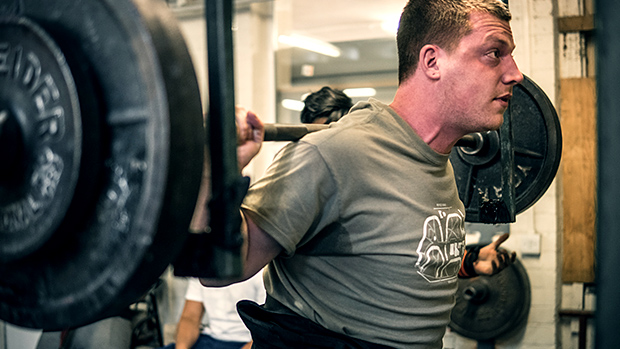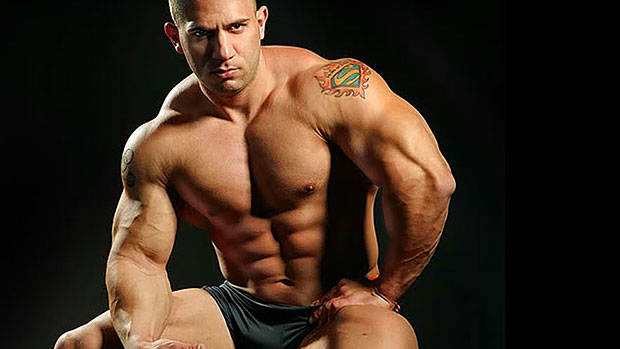Squats are king.
That's an abbreviation of the widely held opinion that the squat is the king of exercises for strength and mass development. Of course, those not into the whole monarchy thing might also refer to squats as weight training's Great Uniter, as their unmatched awesomeness is one of the rare things that bridges the at-times troubled divide between powerlifters, bodybuilders, athletes, and other weightlifters.
Consider the following.
- Weightlifters use squats to help improve their clean and jerk and snatch.
- Athletes use squats to help them sprint faster, jump higher, and throw further.
- Bodybuilders use squats to build the musculature in their hamstrings, glutes, and quads.
- Powerlifters practice the squat because it's one of the three official powerlifts.
So if you're serious about building muscle, some version of the squat should appear in your program. However, many squat with form that's basically an injury waiting to occur.
I've spent over 20 years practicing and teaching the squat, and what I'm about to share are the very same things that have helped me squat 1214 pounds. (And make no mistake; the squat helps the deadlift in a big way.)
Here's how to squat to your strength potential and minimize injury-risk in the process.
Raw Versus Gear
First, one issue to clarify: raw versus equipped squatting.
Many talk about squat form as if it's the same regardless if you squat raw or equipped. This is a mistake. Although there are more similarities than differences, the differences between the two styles are significant enough to warrant further consideration.
For this reason, I'll first describe the correct technique for raw squatting (walking the bar out). This is for raw powerlifters, athletes, and bodybuilders. I'll follow with the correct technique for equipped squatting (using a mono-lift). Naturally, this will apply mostly to powerlifters.
The Raw Squat
Clothes
Any comfortable sports clothing will work, so long as it isn't restrictive.
Shoes
The one area that does warrant attention is footwear. The best options are dedicated squat shoes like the ones I wear from Inzer (different options are available from other powerlifting companies). These squat shoes are flat-soled and provide good ankle support. They're pricey but last a long time. A cheaper option that still offers a flat sole is the classic Converse All Stars, or Chuck Taylors. Just beware that they're not as durable and don't have the same level of ankle support.
What you don't want to wear are those awful cross trainers with air-bubbles. Not only are these abominations grossly overpriced, they're also incredibly unstable and will rob you of pounds on the bar while inviting knee and ankle injury.
Belts & Wraps
You still have the option of wearing a weightlifting belt, wrist wraps, and knee wraps when squatting raw. Whether you do is up to you, but here are some things to think about.
- Belts will increase pressure and the feeling of tightness in your core and should allow you to squat more weight. I usually have athletes belt up from around 40% of their maxes.
- Wrist wraps offer support and protection for the wrists.
- Knee wraps offer rebound out of the hole and help you squat more weight. Some lifters get more carry-over than others from knee wraps. (If you compete in a raw federation that doesn't allow knee wraps, it should go without saying that you shouldn't use them in your training). Some think that the wraps also help to keep the knees tracking the toes when squatting.
- If you're an athlete you may want to squat without a belt, wrist wraps, or knee wraps. You can't wear those items when competing in your sport so you might want to get your body strong without them.
The Set-up
This is the most crucial part of your squat. Get it wrong and nothing else will be right; get it right and you lay the foundation for a good squat. Ed Coan, the greatest pound-for-pound powerlifter of all-time, used to spend a long time just getting under the bar and finding the exact point to have the bar on this back. His results speak for themselves.
How to set up correctly
- The bar should be set up in a power rack (or on squat stands) at chest height. If you set the bar too high you'll have to calf raise it out of the racks, and if it's too low you'll have to do a quarter squat to get the bar clear. Both scenarios are less than optimal and will disrupt your set-up.
- Grab the bar using a full grip (not thumbless). Use the power rings to make sure your grip is even.
- Position your feet directly under the bar and set them hip-width apart.
- Squeeze your shoulders back and down and get your upper back tight, then duck your head under the bar and place the bar across your shoulders. (Finding the right position for you will take some experimentation.)
- Keeping your lower back arched and your chest out. Drive your head back into the bar and take a deep breath of air into your belly.
- Un-rack the bar by arching it out of the rack and then taking a small step back with your left foot, then doing the same with your right foot. (Walking the bar out any further than a few inches is simply a waste of energy and time.)
- Your feet should be around shoulder width apart and toes turned out 10 to 40 degrees.
You're now set up and ready to squat. Again, finding your optimal stance width will take some experimentation.
The Eccentric Motion
To begin the descent, take another deep breath into your belly, push the knees out to the sides, and sit back. Descend until the crease of your hip is just below the top of your knee (when viewed from the side).
When you're "in the hole," here's how your raw squat should look:
- Shins should be close to vertical.
- Knees should be tracking your toes.
- Lower back should be arched.
- Upper back should be tight, with the shoulders pulled back and down and the chest forced out
- Head should be driven back into the bar and you should be looking straight ahead or slightly up.
The Concentric Motion
Once you hit depth, reverse the motion by driving with all that you've got. Now's the time to get aggressive. Your goal is to generate as much tension and force as possible and unleash it all on the bar that's trying to crush you.
Be sure to keep your upper back tight and continue looking forwards. If you look down and lose the tightness in your upper back you could lose the weight forwards or even have it roll over your head. I've seen this happen and it's scary – especially with a PR on the bar.
A very important point is to hold your breath until you've locked the bar out, or at least until past the sticking point.
Once you've successfully driven the bar back to the start position, either take in more air and perform another rep or rack the bar. Don't be sloppy when racking – stay tight and avoid relaxing until the bar is safely resting in the power rack or squat stands.
The Equipped Squat
The big difference between squatting equipped and squatting raw is stance width. The more equipment a powerlifter wears, the wider he can take his stance. This wide stance is also much easier to achieve in a mono-lift, as there's no walk out.
The wider the stance, the shorter the range of motion, the more you can sit-back, and the more glute and hamstring dominant the squat becomes. The forward lean of the torso will also be greater with the wider stance. This is necessary to counterbalance the hips sitting way back.
In contrast, look at an Olympic style front squat: a much closer stance, knees travelling way forwards and a much more upright torso position throughout.
Neither is right or wrong, just different. Still, you must be aware of these differences if you're to understand and improve your own squat style.
You can make a real mess of your squat if you try to squat too wide without equipment. The powerlifting equipment provides immense protection for the hips and rebound out of the hole. Trying to squat excessively wide raw will likely lead to two undesirable outcomes.
First, your power out of the hole will be worse than with a shoulder width stance. And if you can't get the weight out of the hole, it doesn't matter how strong your lockout is because you won't have a chance to show it off.
Second, your hips will start to feel beat up. This could happen right away or after a few weeks.
Equipped lifters should be aware that wearing equipment is not a license to squat as wide as you can place your feet. If your knees start to drift inwards (provided this has never happened before), it's probably because you're squatting wider than optimal for your leverages and flexibility.
That said, here are the key points to squatting equipped out of a mono-lift.
- Set up with your feet directly under the bar and in exactly the position you want to have them in when you squat. They will not move from this position until you've finished your set and racked the bar. If they do, what's the point in using the mono-lift?
- On the way down, trust your equipment and sit way back. In the hole, your shins should be vertical or very close to vertical. If you can't achieve this position then your form needs work and your hamstring strength is lacking.
- Keep the lower back arched, the upper back tight, chest out, and head driven back into the bar.
Conclusion
Regardless if your focus is strength, adding muscle, or sprinting faster, the squat can help you succeed and should be an integral part of your strength-training program.
Ed Coan, Donnie Thompson, Tom Platz, and Ronnie Coleman are all very different lifters, yet each placed an emphasis on developing a massive squat to help reach their respective goals.
However, understand that the squat is a technical movement, and technique is paramount. Before you start piling on the plates, make sure you can squat correctly – and once you have good form, work on it for life. There's always ways to improve.
When it comes to squats, there's no standing still or maintaining, only progression or regression.





